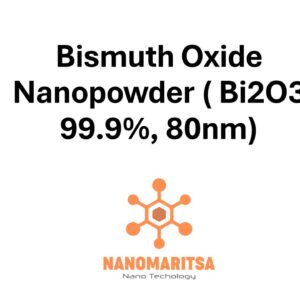Titanium Oxide Nanopowder (TiO2, rutile, high purity, 99.9+%, 30nm)
€128.00
CompareTitanium oxide nanopowder (TiO2, rutile, high purity, 99.9+, 30nm) is a high-quality material renowned for its excellent stability, optical properties, and photocatalytic efficiency. This rutile-phase TiO2 nanopowder, with a purity of over 99.9% and a particle size of 30 nanometers, offers a unique set of characteristics that make it suitable for a wide variety of applications in diverse industries such as energy, environmental, electronics, and coatings.
Composition and Structure
TiO2 (Titanium Dioxide):
Titanium dioxide is a naturally occurring oxide of titanium, known for its strong UV absorption properties, non-toxic nature, and versatility. It is widely used in pigments, photocatalysis, and energy-related technologies.
Rutile Phase:
The rutile form of TiO2 is the most stable and dense crystalline phase, known for its superior optical properties and high refractive index. Compared to the anatase phase, rutile TiO2 exhibits better performance in certain applications, particularly in coatings and pigments, as well as in photocatalytic processes under UV light.
Purity (99.9+%):
With a purity of 99.9% or higher, this nanopowder is free from significant contamination, ensuring high performance in sensitive applications where even trace impurities could affect functionality.
Particle Size (30 nm):
The 30 nm particle size provides an excellent balance of high surface area and good structural integrity, making it highly effective for photocatalytic and other advanced technological applications.
Properties
- Photocatalytic Activity:
Rutile TiO2, while generally less photocatalytically active than anatase, still shows significant photocatalytic activity, especially under UV light. It can break down organic pollutants, enabling its use in environmental cleanup applications such as water treatment and air purification. - Optical Properties:
TiO2 rutile has a high refractive index and excellent light-scattering properties, making it highly desirable in applications requiring bright white pigments, UV filters, and optical coatings. - High Stability and Durability:
The rutile phase is known for its excellent chemical and thermal stability. It resists degradation even under harsh environmental conditions, making it suitable for high-performance applications that demand long-lasting durability. - UV Absorption:
Rutile TiO2 absorbs UV light efficiently, which allows it to be used as a UV-blocking agent in sunscreens, coatings, and other protective products. - Electrical Properties:
Rutile TiO2 exhibits good electrical conductivity under certain conditions, which makes it suitable for use in electronic applications such as sensors and energy storage devices.
Applications
1. Environmental and Energy Applications:
Photocatalysis for Pollution Control:
Rutile TiO2 is effective at degrading organic pollutants when exposed to UV light, making it useful for cleaning polluted air and water. It can be used in photocatalytic reactors for environmental remediation.
Water Treatment:
It is used in water purification systems to remove harmful substances, including dyes, pesticides, and organic compounds, via photocatalysis.
Solar Energy Conversion:
Rutile TiO2 is utilized in solar cells, especially dye-sensitized solar cells (DSSCs), where its high stability and electrical properties contribute to energy conversion.
Hydrogen Production:
TiO2 is also studied for photocatalytic water splitting to produce hydrogen, which could serve as a sustainable fuel source.
2. Pigments and Coatings:
White Pigments:
Rutile TiO2 is the most widely used white pigment in the paint, coating, and plastics industries. Its bright whiteness, high opacity, and non-toxic nature make it the preferred choice for many applications.
Protective Coatings:
Rutile TiO2 is used in high-performance coatings for anti-corrosion, anti-fouling, and self-cleaning surfaces. It provides long-lasting protection against UV degradation and physical wear.
3. Electronics and Sensors:
Electronics Components:
The electrical properties of rutile TiO2 make it useful in sensors, where it can detect changes in environmental conditions, such as humidity, gas concentration, and temperature.
Energy Storage:
TiO2 is incorporated into energy storage devices, such as lithium-ion batteries and supercapacitors, to enhance the performance and stability of these systems.
4. Cosmetics and Personal Care:
Sunscreens and UV Filters:
Due to its ability to absorb UV light, rutile TiO2 is commonly used in sunscreens and other personal care products to protect the skin from harmful UV radiation.
Cosmetics:
In addition to sun protection, TiO2 is used in cosmetics to provide opacity, improve texture, and act as a filler or pigment in products such as foundation, concealers, and powders.
Safety and Handling
Health Considerations:
Titanium dioxide is generally recognized as safe for use in consumer products. However, as with all nanopowders, handling should be done with care. Inhalation or direct contact with the skin should be avoided, and appropriate safety measures such as gloves, masks, and protective clothing should be worn.
Environmental Impact:
TiO2 is non-toxic and environmentally friendly, but there is ongoing research into the long-term effects of nanoparticles in the environment. Its potential accumulation in ecosystems requires further investigation to ensure its sustainability.
Summary
Titanium oxide nanopowder (TiO2, rutile, high purity, 99.9+, 30nm) is a high-performance material with a wide range of applications, including in environmental cleanup, energy conversion, pigments, coatings, electronics, and personal care products. Its excellent photocatalytic properties, UV absorption capabilities, high stability, and electrical characteristics make it a versatile material for advanced technological and industrial uses. The high purity and controlled particle size ensure that it meets the rigorous demands of modern science and industry.
| Measurement (gr) | 100 grams, 500 grams, 1000 grams |
|---|






